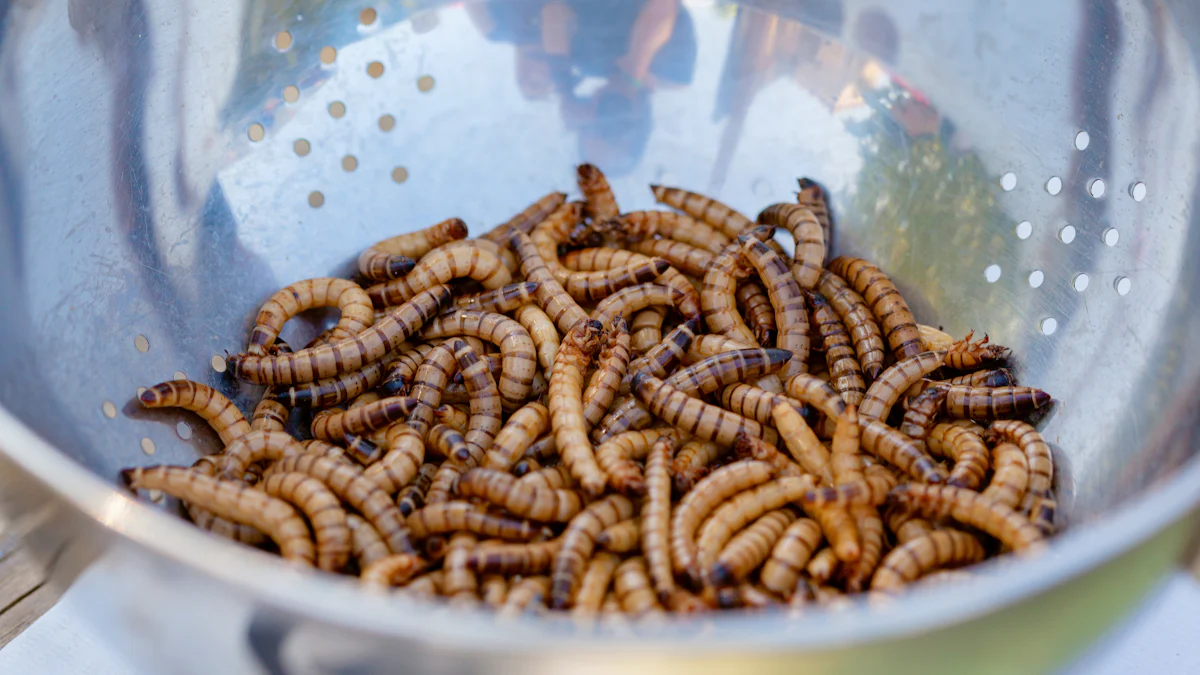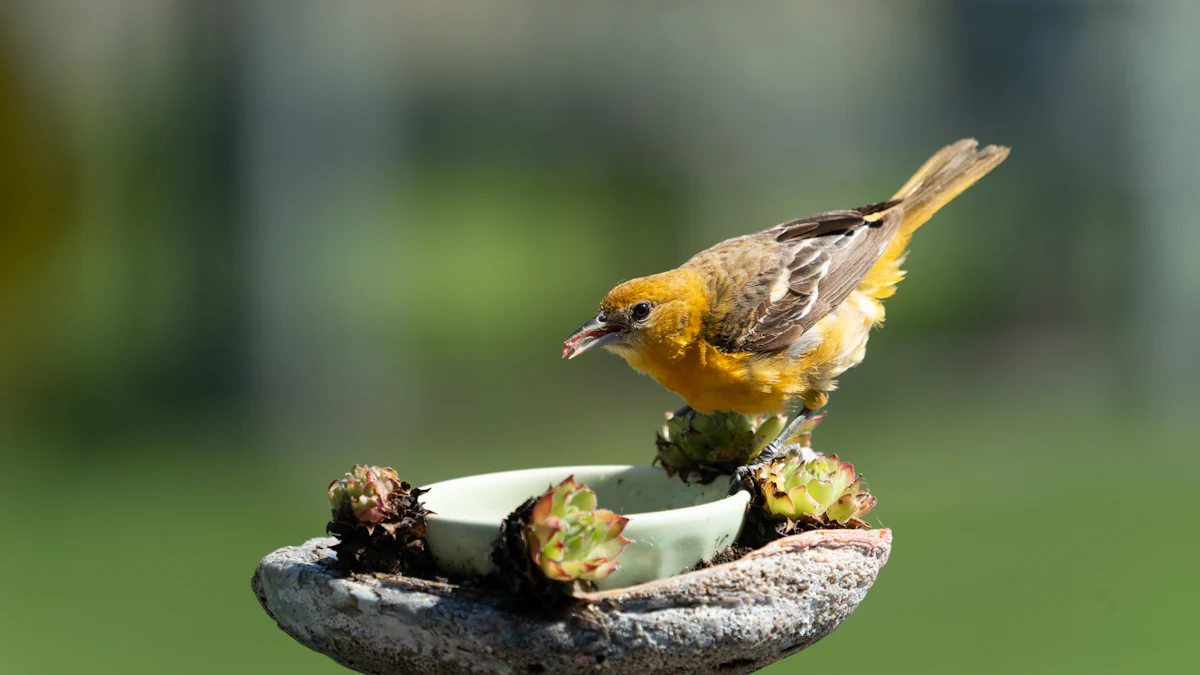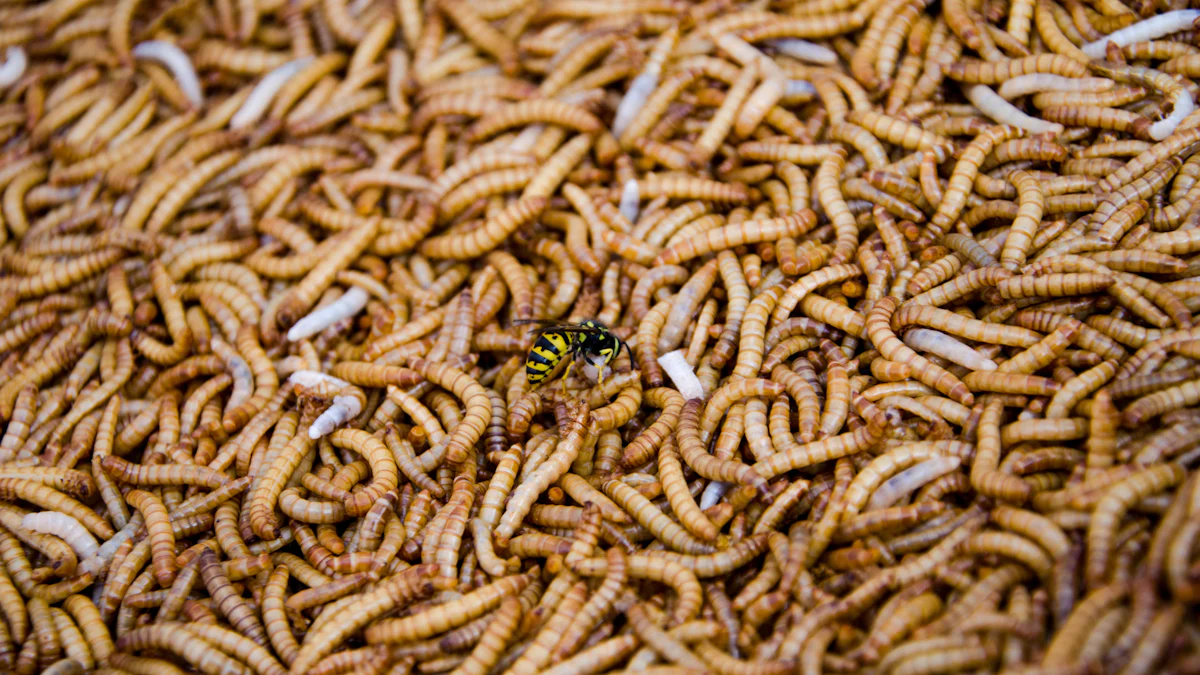
Dried mealworms are a powerhouse of nutrition for birds. Packed with protein, fats, and fiber, they provide essential energy for wild birds throughout the year. Soaking them in water boosts hydration, especially during hot summer days. Offering mealworms can attract bluebirds, robins, and chickadees, creating a lively backyard. Compared to live mealworms for birds, dried ones are more convenient and cost-effective.
Key Takeaways
- Dried mealworms are healthy for birds. They have protein, fats, and vitamins that keep birds strong all year.
- Soaking dried mealworms in water makes them soft and tasty. This is helpful in hot weather when birds need water.
- Mixing dried mealworms with seeds or suet brings more birds. It gives them a balanced meal and makes birdwatching fun.
Why Dried Mealworms Are Beneficial for Birds

Nutritional Value of Dried Mealworms
Dried mealworms are a nutritional powerhouse for wild birds. They are packed with protein, fats, and essential vitamins that support bird health throughout the year. Protein, which makes up about 52.8% of dried mealworms, helps birds build strong muscles and feathers. The fat content, around 24.7%, provides energy, especially during colder months or periods of high activity. Birds also benefit from vitamins like B12 and B2, which aid in energy metabolism.
Here’s a quick breakdown of their nutritional composition:
| Nutrient | Amount |
|---|---|
| Crude Protein | 52.8% |
| Crude Fat | 24.7% |
| Calcium | 0.05% |
| Phosphorus | 1.03% |
| Sodium | 0.097% |
| Manganese | 23 ppm |
| Zinc | 144 ppm |
These nutrients make dried mealworms a reliable food source for birds all year round. Soaking them in water before feeding can also provide hydration, which is especially helpful during hot summer days.
Supporting Birds During Breeding and Migration
Breeding and migration seasons are demanding times for birds. Dried mealworms offer a concentrated source of protein and fat, which are crucial for muscle development, feather strength, and energy. During breeding, nestlings need extra nutrients to grow strong and healthy. Mealworms help meet these needs.
For migrating birds, the high energy content in mealworms supports long flights and helps them recover from the journey. Their rich protein and amino acids also aid in maintaining overall health during these challenging periods. Offering dried mealworms during these seasons can make a significant difference in supporting local bird populations.
Comparing Dried Mealworms to Live Mealworms for Birds
Birds often prefer live mealworms because their movement triggers hunting instincts. However, dried mealworms are just as nutritious and far more convenient. They don’t require refrigeration or special care, making them an economical choice for bird enthusiasts.
Transitioning birds from live mealworms to dried ones can take time, especially for picky species like bluebirds. A helpful strategy is to start with live mealworms and gradually mix in dried ones. Soaking dried mealworms in lukewarm water can also make them more appealing by mimicking the texture of live mealworms. While live mealworms for birds may attract attention faster, dried mealworms are a practical and effective alternative.
How to Feed Dried Mealworms to Birds
Using Feeders for Dried Mealworms
Feeders are an excellent way to offer dried mealworms to birds while keeping your yard tidy. Platform or tray feeders work best because they provide an open space for birds to perch and feed comfortably. Some feeders come with containers specifically designed for mealworms. These containers should have sides at least 1 inch tall to prevent mealworms from spilling out. A roof or drainage holes can also protect the mealworms from rain, keeping them fresh and dry.
For those who enjoy watching birds up close, placing the feeder near a window or patio can create a delightful viewing experience. Regularly cleaning the feeder ensures it stays hygienic and safe for birds.
Mixing Mealworms with Seeds or Suet
Combining dried mealworms with seeds or suet can make your bird food more appealing. Birds that are hesitant to try mealworms may be drawn in by the familiar texture of seeds or the rich flavor of suet. This mix also provides a balanced diet, offering both protein from the mealworms and energy from the seeds or suet.
To prepare this blend, simply sprinkle a handful of dried mealworms into your usual birdseed mix or press them into a suet cake. This method works well in winter when birds need extra calories to stay warm.
Soaking Dried Mealworms for Added Hydration
Soaking dried mealworms in water restores the moisture lost during the drying process. This makes them softer and easier for birds to eat. Hydration is especially important during hot summer months or for birds that don’t have easy access to water.
To soak mealworms, place them in a bowl of lukewarm water for about 20-30 minutes. Once they’ve absorbed enough water, drain the excess and serve them in a feeder or on a tray. Soaked mealworms closely resemble live mealworms for birds, making them more enticing to picky eaters.
Offering Mealworms on Ground Trays or Platforms
Some birds prefer feeding on the ground, so using a ground tray or platform can attract species like robins and blackbirds. Ground trays provide a natural feeding experience and allow multiple birds to feed at once.
To keep the mealworms clean, choose a tray with small drainage holes to prevent water buildup. Place the tray in a safe spot, away from predators like cats. Regularly moving the tray to different areas of your yard can also help prevent pests from gathering.
Which Birds Eat Dried Mealworms?

Common Backyard Birds That Enjoy Mealworms
Many backyard birds love dried mealworms for their high protein and fat content. These birds often visit feeders or trays to enjoy this nutritious treat. Some of the most common species include:
- Bluebirds
- Chickadees
- Thrushes
- Titmice
- Wrens
- Nuthatches
- Kinglets
These birds are frequent visitors to yards where dried mealworms are offered. Adding mealworms to your feeding routine can attract a lively mix of feathered friends.
Seasonal Visitors Attracted by Mealworms
Dried mealworms are especially appealing to birds during migration and breeding seasons. Their energy-rich nutrients help birds stay strong during these demanding times. Seasonal visitors that enjoy mealworms include:
- Bluebirds, drawn to their taste and nutrition.
- Chickadees, which eagerly visit feeders for mealworms.
- Robins, especially during breeding season when they need extra energy.
- Wrens, which rely on mealworms to fuel their high metabolism.
- Woodpeckers, like Downy and Hairy species, that enjoy mealworms as a supplement.
- Nuthatches, which often carry mealworms back to their nests for their young.
Offering mealworms during these seasons can make your yard a haven for migrating and breeding birds.
Identifying Birds That Prefer Mealworms
Birdwatchers can easily spot birds that prefer mealworms. These species often show specific behaviors around feeders or trays:
- Bluebirds frequently visit feeders stocked with mealworms.
- Chickadees, small and lively, become regular visitors for mealworms.
- Robins often scavenge for mealworms on the ground or in feeders.
- Wrens hop energetically around feeders, snapping up mealworms.
- Woodpeckers, such as Downy and Hairy, relish mealworms as part of their diet.
- Nuthatches carry mealworms back to their nests to feed their young.
These birds are easy to identify by their feeding habits and enthusiasm for mealworms. Whether you offer dried or live mealworms for birds, these species will likely become regular visitors.
Challenges of Feeding Dried Mealworms and How to Overcome Them
Managing the Cost of Dried Mealworms
Dried mealworms are a fantastic food source for wild birds, but their cost can add up quickly. Buying in bulk is one of the easiest ways to save money. Large quantities often come at a discounted price, making it more affordable in the long run. Another option is to mix mealworms with other bird food, like seeds or suet. This stretches the supply while still providing birds with a nutritious treat.
For those who enjoy gardening, raising live mealworms at home can be a cost-effective alternative. Once dried, they can be stored and used just like store-bought mealworms. While this requires some effort, it’s a rewarding way to save money and ensure a steady supply.
Preventing Pests and Unwanted Animals
Dried mealworms can attract more than just birds. To keep pests and predators away, proper storage and feeding practices are essential.
- Use containers with tight-fitting lids to block access.
- Regularly inspect storage boxes for signs of pests or eggs.
- Replace the substrate periodically to prevent mold or bacteria.
- Sprinkle diatomaceous earth around storage areas as a safe pest deterrent.
When feeding, avoid leaving mealworms out overnight. This reduces the chances of attracting raccoons, squirrels, or other unwanted visitors.
Proper Storage to Maintain Freshness
Keeping dried mealworms fresh ensures birds get the best nutrition. Store them in airtight containers to protect against moisture and pests. For long-term storage, freezing mealworms at temperatures below -15°C can extend their shelf life for over six months.
If freezing isn’t an option, drying mealworms further or converting them into powder can help preserve them. Always store mealworms in a cool, dry place to prevent spoilage. Maintaining proper storage conditions keeps mealworms safe and appealing for birds.
Encouraging Birds to Try Mealworms
Some birds may hesitate to try dried mealworms, especially if they’re unfamiliar with them. Offering live mealworms initially can help attract their attention. Once birds recognize mealworms as food, transitioning to dried ones becomes easier.
Soaking dried mealworms in lukewarm water makes them softer and more appetizing. This method mimics the texture of live mealworms, making them more appealing to picky eaters. Placing mealworms in a visible spot, like a tray or platform feeder, also helps birds discover this nutritious treat.
Feeding birds dried mealworms offers countless benefits. Packed with protein, fats, and fiber, they support muscle growth, feather strength, and energy needs year-round. Experimenting with feeders, suet, or fruit combinations can attract diverse species. By offering mealworms, bird enthusiasts help sustain local bird populations while enjoying the joy of a vibrant, feathered backyard community.
FAQ
What makes dried mealworms a good food source for birds?
Dried mealworms are packed with protein, fats, and fiber. They provide essential energy and nutrients, making them a great year-round food for wild birds.
Should dried mealworms be soaked before feeding?
Soaking dried mealworms in water restores moisture, making them softer and easier to eat. This also provides birds with hydration, especially during hot summer months.
How can I attract birds that are hesitant to try mealworms?
Mix dried mealworms with seeds or suet. Soaking them in water can also make them more appealing by mimicking the texture of live mealworms.


